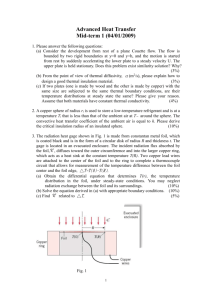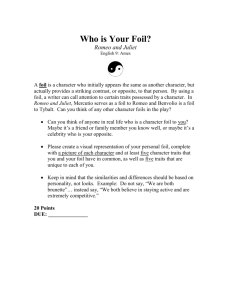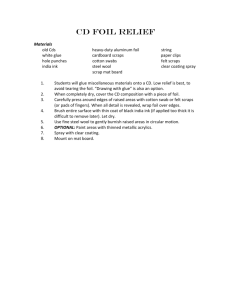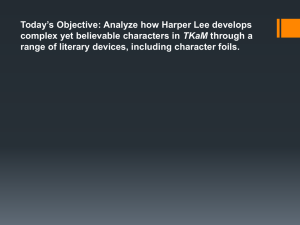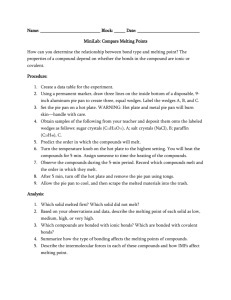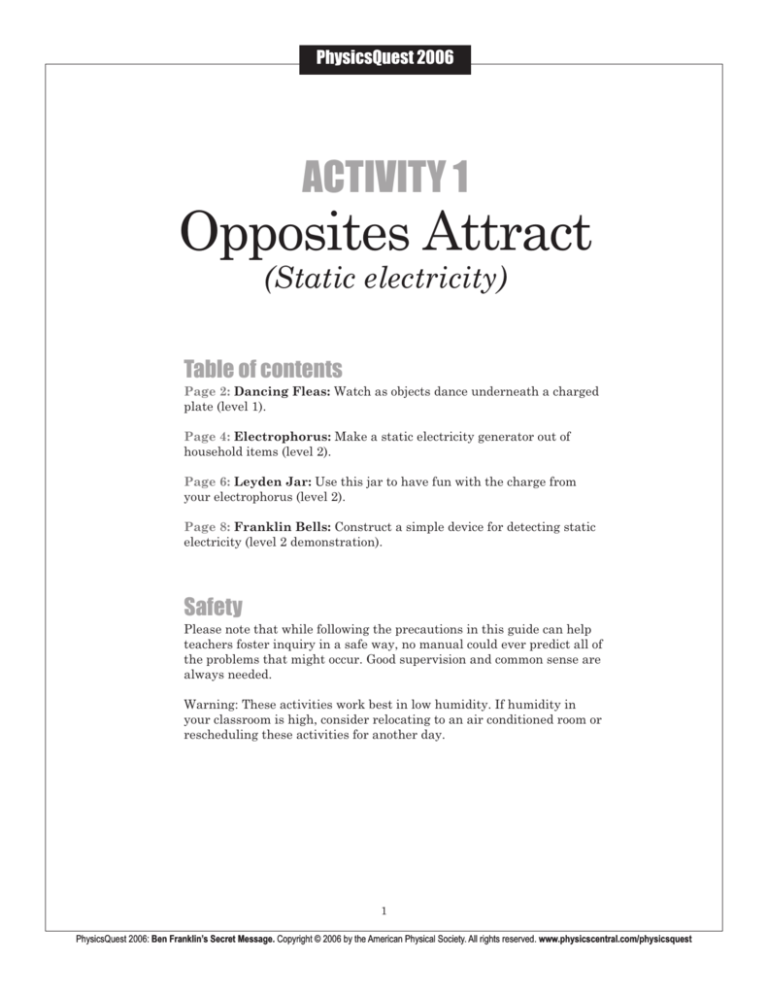
PhysicsQuest 2006
ACTIVITY 1
Opposites Attract
(Static electricity)
Table of contents
Page 2: Dancing Fleas: Watch as objects dance underneath a charged
plate (level 1).
Page 4: Electrophorus: Make a static electricity generator out of
household items (level 2).
Page 6: Leyden Jar: Use this jar to have fun with the charge from
your electrophorus (level 2).
Page 8: Franklin Bells: Construct a simple device for detecting static
electricity (level 2 demonstration).
Safety
Please note that while following the precautions in this guide can help
teachers foster inquiry in a safe way, no manual could ever predict all of
the problems that might occur. Good supervision and common sense are
always needed.
Warning: These activities work best in low humidity. If humidity in
your classroom is high, consider relocating to an air conditioned room or
rescheduling these activities for another day.
1
PhysicsQuest 2006: Ben Franklin’s Secret Message. Copyright © 2006 by the American Physical Society. All rights reserved. www.physicscentral.com/physicsquest
Dancing Fleas
Use static electricity to make objects dance.
Safety
The edges of the plexiglass sheet may be sharp, especially if it was cut down to size for you, so be careful.
Materials
■ A piece of wool
■ Plexiglass sheet
■ 2 textbooks, each about 2.5-cm thick
Instructions
1. Tape the piece of paper down on
a desk and sprinkle some of the
“tiny objects” over the paper.
■ A piece of white paper
An assortment of tiny objects, for example:
■ Paper squares (colored paper is easier to see)
■ Aluminum foil squares
■ Puffed rice cereal
■ Grains of rice
2. Use the textbooks to suspend
the plexiglass sheet directly over
the paper, as shown below.
3. Rub the top of the plexiglass
sheet with the wool and record
what happens.
Wool
Plexiglass
Book
Paper
Table
Graphics by Kerry G. Johnson
Discussion questions
■ How can we use static electricity to make objects move?
■ What kinds of materials are affected by electric charges?
■ How strong is the force of an electric charge compared to the force of gravity?
■ How could you test this?
2
PhysicsQuest 2006: Ben Franklin’s Secret Message. Copyright © 2006 by the American Physical Society. All rights reserved. www.physicscentral.com/physicsquest
FOR THE TEACHER
(Level 1)
Dancing Fleas
Materials
■ 12-inch x 12-inch or larger sheet of 1/8-inch thick plexiglass (acrylic)
Available at hardware stores. Often you order the sheet at the check-out counter and they cut it to size for you. Approximately $5.
■ A piece of wool, approximately 10-cm x 10-cm or larger*
You can purchase wool felt by the yard at most fabric stores. You can also purchase wool cloths from science supply stores,
such as Science Kit & Boreal Labs, www.sciencekit.com, part number WW2742300. $6.60 / 12-inch x 24-inch cloth.
■ 2 textbooks, each about 2.5-cm thick
■ 1 piece of white paper
Discussion
An assortment of tiny objects, for example:
■ Paper squares (colored paper is easier to see)
■ Aluminum foil squares
■ Puffed rice cereal
■ Grains of rice
Materials are attracted to the plexiglass after it is rubbed. This is because the wool deposits extra electrons on
the sheet, giving it an overall negative charge. The electrons in the tiny objects are then repelled by the sheet
and move to the bottom of the pieces, leaving the positively charged protons near the sheet. The objects move
up toward the plexiglass (as long as they are not too heavy) because the protons are attracted to the negatively
charged plexiglass.
Students may notice that some of the bits of paper stick completely to the plexiglass sheet while others hang
by an edge. The bits that hang by an edge have a high concentration of electrons in part of the paper farthest
from the sheet; if you remove the electrons by touching the paper, it will then stick completely to the plexiglass.
Another notable result is that the aluminum foil bits often bounce back and forth rapidly between the paper
taped to the desk and the plexiglass, while other materials move much slower or stick completely to the plexiglass the first time they hit it. This is because the conducting foil quickly picks up electrons from the plexiglass.
This causes the foil bits to be repelled from the sheet, so they fly back to the paper They deposit the electrons on
the paper, and then are attracted to the plexiglass again. To magnify this effect, place a large piece of aluminum
foil under the plexiglass instead of the paper.
Suggested resources
Bell, Trudy E. “Crackling Planets” Science@Nasa, 2005.
http://science.nasa.gov/headlines/y2005/10aug_crackling.htm?list78675
Article about charging by rubbing as a concern for exploration of the Moon and Mars.
“Static Electricity: What causes static shocks?” Science Made Simple, Inc., 2005.
http://www.sciencemadesimple.com/static.html
Static electricity basics with background information on atoms and charge.
Bibliography
“Electrical Fleas: Start your own electric flea circus.” Exploratorium Snacks.
http://www.exploratorium.edu/snacks/electrical_fleas.html
3
PhysicsQuest 2006: Ben Franklin’s Secret Message. Copyright © 2006 by the American Physical Society. All rights reserved. www.physicscentral.com/physicsquest
The Electrophorous
Create your own electrophorus – a device developed over 200 years ago for creating static charge.
Safety
You will be building up small amounts of static charge in this activity and could receive shocks.
Materials
■ A Styrofoam plate
■ An aluminum pie pan
■ A piece of wool
■ Adhesive tape
Making the electrophorus
1. Tape the plate
upside down to
the center of a desk.
■ A Styrofoam cup
■ A paper clip
Using the electrophorus
2. Tape the cup to the middle of the
top of the aluminum pie pan,
top down, to make
a handle.
Cup
Plate
■ Aluminum foil
A. Set aside the top (pie pan / Styrofoam
cup) and rub the surface of the Styrofoam
plate with wool for a full minute.
B. Touching only the Styrofoam cup handle,
set the pie pan back on top of the plate.
C. Touch the pie pan
(you should feel a
slight shock).
Pie pan
+ + + + +
D. Lift up the pie pan by
- - - - the Styrofoam cup handle.
The foil should flip away from the pan.
3. Bend the paper clip so that one
end is a base and the other
makes a horizontal arm.
E. Touch the pie pan again. You should feel
a shock and see the foil flip back down.
The pie pan can be charged multiple times
without recharging the Styrofoam plate by
rubbing, but the Styrofoam plate will loose
charge slowly to the air and surroundings,
especially in humid weather.
Foil
Discussion questions
4. Tape the base of the paper clip to
the top of the pie pan next to
5. Place the pie pan on top of
the cup, and hang a small strip of
the plate. Your electrophorus
aluminum foil (about 0.5-cm x 4-cm)
should look like the
over the horizontal arm.
picture above.
4
■ Why doesn’t the Styrofoam plate loose all
its charge to the pie pan?
■ Do you think there is a limit to the amount
of charge you can build up on the plate?
■ What is the role of the foil strip?
■ How can you turn this static electricity into
useful energy?
Graphics by Kerry G. Johnson
PhysicsQuest 2006: Ben Franklin’s Secret Message. Copyright © 2006 by the American Physical Society. All rights reserved. www.physicscentral.com/physicsquest
(Level 2)
FOR THE TEACHER
The Electrophorous
Materials
■ An aluminum pie pan. Available in the baking section of the grocery store for a few dollars.
■ Piece of wool, approximately 10-cm x 10-cm or larger. You can purchase wool felt by the yard at most fabric stores. You can also purchase wool cloths
from science supply stores, such as Science Kit & Boreal Labs, www.sciencekit.com,part number WW2742300. $6.60 / 12”x24” cloth.
■ Styrofoam plate
■ Styrofoam cup
■ Aluminum foil
■ Adhesive tape
Discussion
When the pan is lifted, the positive charges redistribute evenly on
its surface and the aluminum foil strip (D). This causes the aluminum foil strip to flip up, since it is repelled from the similarly
charged pan.
If you (or any other conductor) now touch the pie pan, electrons
will flow back to the pan, creating another spark and leaving the pan
neutral once again. When the pan discharges, the foil flips back
down because it and the pan are now neutral and no longer repel one
anther.
Note that the Styrofoam plate does not lose any charge in this
process; only the charges in the pie pan move around. This is called
charging by induction, and explains why the pan can be recharged
without rubbing the plate again.
Rubbing the Styrofoam plate with wool transfers electrons to the
plate, where they stay because the plate is an insulator (A). When the
intially neutral conducting pie pan is set on top of the insulating plate,
its extra electrons move to the top surface because they are repelled by
the plate’s negatively charged extra electrons (B). This leaves the
bottom of the pan positively charged.
When you touch the plate (C) the negative charges on the pie pan
are drawn off. This happens because you act as a ground. Even though
the body is electrically neutral, its positive charges attract the free
electrons in the pie tin. Because you are connected to the ground, the
negative charges (electrons) flow through you to the earth without
building up a charge on the body. This process leaves the pan with an
overall positive charge.
+
–
Positive
Negative
Pie
pan
Cup
Paper clip
-
Foil
Plate
Plate
A. The Styrofoam plate is
negatively charged by the
wool. The electrophorus is
initially electrically neutral.
■ A paper clip
B. Electrons on the electrophorus
are repelled by the negatively
charged plate and move toward
the top surface. This leaves the
bottom surface positively charged.
-
-
-
+ + + + +
+ + + + +
- - - - -
C. Electrons near the
top surface of the pan
are drawn off by the
ground.
- - - - -
D. The electrophorus is left
with an an overall positive
charge that redistributes
when the plate is lifted.
Suggested resources
“Charge and Carry: Store up an electric charge, then make sparks.” Exploratorium Snacks. http://www.exploratorium.org/snacks/charge_carry.html
Another form of the electrophorus and Leyden jar activities with a good explanation.
“Static Electricity.” The Physics Classroom, 2004.
http://www.physicsclassroom.com/mmedia/estatics/estaticTOC.html
Use the menu on the left to find out more about various forms of electrostatic induction, including the electrophorus.
Bibliography
“Charge and Carry: Store up an electric charge, then make sparks.” Exploratorium Snacks. http://www.exploratorium.org/snacks/charge_carry.html
Graf, Rudolph F. Safe and Simple Electrical Experiments. New York: Dover Publications, Inc. 1973. Pages 16-18.
Henderson, Tom. “Charging an Electrophorus by Induction Using a Negatively-Charged Object.” Multimedia Physics Studios, 1998.
http://www.glenbrook.k12.il.us/gbssci/phys/mmedia/estatics/epn.html
Jones, Thomas B. “Electrophorus and Accessories.” 2005. http://www.ece.rochester.edu/~jones/demos/electrophorus.html
5
PhysicsQuest 2006: Ben Franklin’s Secret Message. Copyright © 2006 by the American Physical Society. All rights reserved. www.physicscentral.com/physicsquest
The Leyden Jar
Make your own Leyden jar for storing charge.
Safety
You will be building up small amounts of static charge in this activity and could receive shocks.
In addition, be very careful when working with the nails.
Materials
■ 35mm film canister
■ A 2-inch nail or a paper clip with one leg straightened
■ Aluminum foil
■ Adhesive tape
■ Tap water
■ Electrophorus or other static electricity source
Making the Leyden Jar
Using the Leyden Jar
3. Push the nail (or paper clip)
through the top of the canister,
so that the tip of the nail points
toward the inside of the canister.
The head of the nail should
2. Neatly wrap the bottom
stick out a few centimeters.
two thirds of the film
canister in the foil and 4. Fill up the canister most of the
tape it in place securely.
way with tap water and snap the
lid in place. The point of the nail
should be immersed in water.
B. Lift the pie pan off the Styrofoam plate. Hold
the Leyden jar by the foil and drag the top of
the the nail along the edge of the pie pan.
Note that the aluminum foil charge tester on
the electrophorus flips down as the pie pan
touches the nail.
1. Cut a 4-cm x 12-cm
piece of aluminum foil
and smooth it out with
your fingers.
A. Charge the electrophorus as in Extension 1,
but do not discharge it.
C. Charge the pan again and repeat step 2.
Do this several times.
D. Discharge the Leyden jar by touching the nail
and the foil on the jar at the same time (you
will get a shock, but it is not large enough to
be dangerous).
Discussion questions
■ Is there a maximum charge that your jar can
hold? How might you test this?
■ Can you discharge the Leyden jar into other
objects? Try discharging it into a fluorescent
tube or light emitting diode (LEDs) in a
dark room. Do this by touching one lead to
the nail and one lead to the foil.
Water
Foil
Cut-away view
6
■ Can you discharge the Leyden jar without
touching it? Sparks should be able to jump
between your fingers and the charged object
if you hold your fingers close enough.
How far you can make the sparks jump?
Graphics by Kerry G. Johnson
PhysicsQuest 2006: Ben Franklin’s Secret Message. Copyright © 2006 by the American Physical Society. All rights reserved. www.physicscentral.com/physicsquest
FOR THE TEACHER
(Level 2)
The Leyden Jar
Materials
■ 35mm film canister
Usually a camera store will give you empty film canisters
■ A 2-inch nail or a paper clip with one leg straightened
■ Aluminum foil
■ Adhesive tape
■ Tap water
Not purified or distilled
■ Electrophorus or other static electricity source such as a PVC pipe rubbed with wool
Discussion
The pan has a positive charge on it when it leaves the Styrofoam plate. When you drag the nail along the
pan, electrons in the neutral nail are attracted to the positively charged pie pan. These electrons go from the
nail to the pan, neutralizing the pan and leaving the inside of the Leyden jar positively charged. Repeating the
process increases the charge inside the jar.
As the inside of the jar becomes positively charged, the charges in foil on the outside of the jar are also
affected. The electrons in the foil move to the inside-facing side of the foil because they are attracted to the
positively charged interior of the jar. This leaves the outside-facing side of the foil positively charged. Since
you are holding the can by the foil, negative charges in your hand are attracted to the positively charged foil,
and they flow into the foil. This leaves the foil with an overall negative charge.
When you touch the aluminum foil and the nail at the same time, electrons flow through your hand from
the foil to the water, neutralizing the charge inside the jar and giving you a shock.
If you are working with a more advanced class, you may wish to challenge your students to write an explanation of how the charges are moving throughout the process of charging and discharging the Leyden jar. This
exercise will be most effective when groups discuss their explanations and use pictures to visualize how the
charges flow.
Suggested resources
“Charge and Carry: Store up an electric charge, then make sparks.” Exploratorium Snacks.
http://www.exploratorium.org/snacks/charge_carry.html
Another form of the electrophorus and Leyden jar activities with a good explanation.
Katz, Eugenii. “Leyden Jars.” http://chem.ch.huji.ac.il/~eugeniik/instruments/archaic/leyden_jars.htm
History of the Leyden jar and pictures of various types of jars.
Bibliography
“Charge and Carry: Store up an electric charge, then make sparks.” Exploratorium Snacks.
http://www.exploratorium.org/snacks/charge_carry.html
7
PhysicsQuest 2006: Ben Franklin’s Secret Message. Copyright © 2006 by the American Physical Society. All rights reserved. www.physicscentral.com/physicsquest
FOR THE TEACHER
(Level 2)
Franklin’s Bells
This is a simple device for detecting static electricity that works with a television or CRT (non-flatscreen)
computer monitor. Franklin used a similar device in his house to let him know when static electricity was
in the air, like during a thunderstorm.
It is recommended that Franklin’s Bells be done as a demonstration because there are safety concerns
about having students work with the static charges on TV / computer screens. Construction is simple
enough that inspecting the finished product enables students to understand how the bells are made.
Safety
An uncomfortable and possibly dangerous shock can result from discharging the electric charge of a TV screen
or computer monitor through your body. Be sure to connect the second can to a ground (such as the metal on
the back of a computer or the metal leg of a table or chair). Only touch the bells and screen when the screen
is turned off and the bells have stopped ringing.
Materials
■ Two empty
soda cans, at least
one with a pull tab
■ Sewing thread
or thin string
■ Adhesive tape
■ Aluminum foil
■ Plastic pen
■ Two wires with alligator clips*
Called “Insulated Test /
Jumper Leads”, you can
usually find a pack of
10 for less than $6. If not
available at a local hardware
store or RadioShack, you can
purchase them from
RadioShack.com, model 278-1156.
■ TV or CRT computer monitor
(some newer screens are
“non-static” – these won’t work.
If you are having trouble making
the bells ring, try another screen)
Making Franklin’s Bells
1. Break the tab off of one can and tie it to
one end of the thread.
2. Tie or tape the other end of the thread around
the center of the pen so that when hanging from
can level, the tab does not touch the table.
Graphics by Kerry G. Johnson
3. Place the cans about thee centimeters apart, and lay
the pen on top of them so that the tab is suspended
between the cans. Make sure the tab is not touching
either can.
8
PhysicsQuest 2006: Ben Franklin’s Secret Message. Copyright © 2006 by the American Physical Society. All rights reserved. www.physicscentral.com/physicsquest
Grounded item
Graphics by Kerry G. Johnson
4. Connect one can to a ground, such as the metal part of a computer frame, using one of the alligator clip wires.
5. Use the other wire to connect the other can to a sheet of aluminum foil about the size of the TV
or computer screen.
6. Turn the screen off, and tape the foil directly to the screen.
7. Turn the screen on – the tab should swing back and forth hitting the cans and creating a bell-like sound
until the charge on the screen is dissipated. You can make the tab continue moving by turning the screen
on and off repeatedly.
Note that the screen becomes charged when it is switched off as well.
Discussion questions
■ What causes the bells to ring?
■ What would happen if you used a metal pen instead of a plastic one?
■ What do you need to connect the second can to ground?
If you have access to
a source of constant static
electricity, such as a Van de
Graaff Generator or Wimshurst
Machine, try connecting the bells
to it after using the TV. The bells
should ring constantly as long
as the machine is turned on.
■ How else could you detect static electricity?
Discussion
The tab moves because it is made of conducting metal and therefore attracted to charged objects. When the
screen is turned on, a static charge accumulates on it (students may have noticed that they can get small
shocks from TV screens). The aluminum foil / wire set-up transfers most of this charge to the first soda can.
The hanging tab is uncharged, and therefore attracted to the charged can by induction.
When the tab strikes the can, some of the can’s charge is transferred to the tab, and the tab is then repelled
from the first can. The charged tab is then attracted to the neutral second can by induction. When it strikes
this can, it transfers its charge to the second can and into the ground through the second wire. After the tab
touches the second can, both the tab and second can are neutral, as at the start of the experiment, and the tab
is attracted to the first can once again. This cycle repeats until all of the charge from the screen has been
moved to the ground by the tab.
Suggested resources
“Franklin Bells.” The Bakken Library and Museum, 2004
http://www.thebakken.org/artifacts/Franklin-Bells.htm
History of Franklin bells and explanation of their use detecting thunderstorms.
Bibliography
Field, Simon Quellen. “Electromagnetism: A High Voltage Motor in 5 Minutes.”
Science toys you can make with your kids.
http://www.scitoys.com/scitoys/scitoys/electro/electro4.html
9
PhysicsQuest 2006: Ben Franklin’s Secret Message. Copyright © 2006 by the American Physical Society. All rights reserved. www.physicscentral.com/physicsquest



